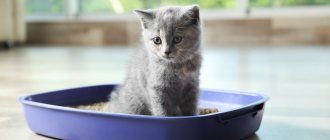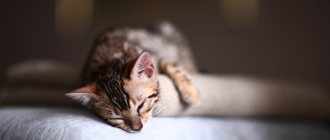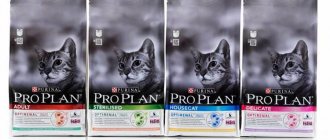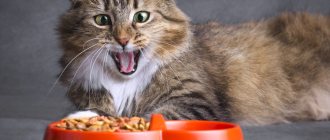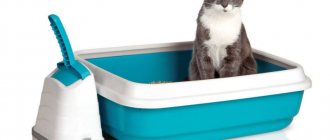Types of litter boxes for cats
Let's take a closer look at the main types of litter boxes for cats.
Low tray
It is a solid rectangular container with low sides.
Advantages:
- compactness;
- price;
- easy to clean;
- quick replacement of the absorbent mixture;
- you can take it with you on the road.
Flaws:
- the smell is not retained;
- filler is definitely needed;
- The cat scoops some of the sand out.
This option is perfect for small kittens; it will be convenient for them to climb into it.
Tray with low sides
High tray
Looks like a rectangular box. It comes with impressive sides that are attached to the edges.
Advantages:
- the absorbent mixture remains and does not spill out onto the floor;
- easy to clean and quick to clean.
The disadvantages include the size compared to other designs.
Additional sides make it possible to use disposable plastic bags, which are sent to the trash bin along with feces.
Tray with high sides
Dry toilet
It has the shape of a house with doors. There are various types of dry closets on sale from rectangular to triangular. A carbon system is built into the walls, which absorbs odor. Filters must be changed every six months.
Main advantages:
- clean air in the apartment;
- sand does not fall out;
- suitable for cats who like to rummage and dig;
- does not require regular care;
- Manufacturers produce models of different sizes and shapes.
The disadvantages include a fairly high price, as well as a not very convenient design (especially for completely closed models).
Dry toilet for cats
Automatic toilet
It is connected to electrical energy and water supply, as a result of which the cleaning procedure is completely automated.
Main characteristics:
- The kit includes all the necessary parts.
- Most devices do not require filler.
- The urine is drained directly into the sewer through a tube.
- The set includes special washing granules.
- A special system grinds cat feces, which is easily washed down the drain.
- The device reacts to movement after the animal leaves and automatically cleans.
- There are several manual rinsing modes, once a day or several times a day.
The obvious disadvantage is the high cost. Breeders also note that many cats are afraid of the automatic device and the cleaning process, so they refuse to use it.
Automatic tray
Tray with mesh
A mesh is attached to the top of the plastic container, through which the urine flows into the tray.
Advantages:
- no absorbent required;
- the mesh and tray are easy to clean;
- the cat stays clean.
Flaws:
- an unpleasant odor spreads throughout the apartment;
- the tray and mesh must be washed regularly;
- Some pets don't like the mesh because their claws get caught in it.
Toilet with mesh
Toilet nozzle
Some owners teach their cat to sit on the toilet. There are special nozzles for this, which come in two types. The nozzle with removable rings is designed for reusable use. It consists of several rings of different sizes. The wider element is inserted into the toilet, and then the rings are changed sequentially as the animal gets used to it. It can be used to train kittens from three months of age.
The device with cut holes can be fixed in two ways on the toilet rim or under it.
Advantages:
- with the help of the nozzle, the cat gradually gets used to the toilet;
- With this device you can save space in the room.
Flaws:
- be patient and time;
- The device is not suitable for all cats.
If your pet is trained to use the toilet, there will be no need to purchase litter and there will be no unpleasant odor in the room.
Toilet nozzles
Travel toilet
The folding tray is made of layers of durable, waterproof fabric.
Advantages:
- light weight;
- compactness;
- easy to clean and wash;
- convenient to use on long trips;
- availability.
Flaws:
- the fabric does not retain odor;
- Can't use it every day.
The travel toilet quickly folds and unfolds and does not take up much space in the suitcase.
Road tray
Criterias of choice
When choosing, inspect the design and reliability of the product.
The toilet should be comfortable for cats, and cleaning should not be inconvenient for the owner. First, they look at the ratio of the dimensions of the tray and the size of the animal. Often a person buys a toilet to grow. As a result, the cat does not climb into it because of the high walls. Also, when choosing, adhere to the following criteria:
- Toilet material. The body should consist of a hard but light material. Often trays are made of plastic. Models that are too light turn over during defecation, which will greatly affect the animal’s psyche. After such a situation, the cat will not want to go into it.
- Smooth surface. The working surface of the tray must be smooth. To check this, just swipe your hand. Any defects: burrs, unevenness, cause harm to the cat.
- Mesh with small holes. Owners of large animals are recommended to purchase a device with a mesh containing small holes. This way, after going to the toilet, the cat’s paws will not remain dirty.
- Functional. Some owners do not intend to clean the trays. It is worth looking at models with automatic cleaning.
- Appearance. The design should not have an unpleasant chemical odor or bright colors that indicate low quality of the device.
- Price. Don't buy the expensive option right away. Some cheap models have more functionality than their expensive counterparts. This is due to the country of manufacture. Foreign models are sold at higher prices.
After purchase, select the location of the tray. If there is not enough space in the bathroom to install a cat litter box, then it is better to place it in the hallway. Open models look unpresentable, so it is better to take options with a lid. In closed toilets, animals will be less embarrassed and feel privacy. Also, the filler will not fall out through the sides after instillation of feces. These types of litter trays are not suitable for active cats; for them it is better to purchase a regular open toilet.
Comparisons of different toilets
Species comparisons
| Kinds | Price | odor removal | For cleanliness in the house | According to the difficulty of washing |
| Low tray | 400-1500 rub. | Doesn't eliminate | The filler is spread throughout the apartment | easy to wash |
| High tray | 400-1500 rub. | Doesn't eliminate | does not spread only if it sticks to the paws | easy to wash |
| tray with mesh | 400-1500 rub. | Doesn't eliminate | doesn't spread | easy to wash |
| Dry toilet | 1300-10000 rub. | Eliminates well due to carbon filters | does not spread only if it sticks to the paws | a little more complicated |
| Auto | 10,000-40,000 rub. | Perfectly eliminates due to automatic draining | does not spread only if it sticks to the paws | no need |
| Toilet nozzle | 1300-3000 rub. | It eliminates perfectly if you train your cat to rinse off | doesn't spread | easy to wash |
| Road | 600-1000 rub. | Doesn't eliminate | does not spread only if it sticks to the paws | easy to wash |
Dry toilets and automatic devices have appeared on the market relatively recently. They do not require special care and prevent the spread of unpleasant odors throughout the apartment. The disadvantage of such designs is the high price.
Special attachments gradually accustom the pet to a standard toilet. A special role is given to the travel toilet, which is convenient to take with you when transporting a cat over long distances.
Also, in addition to the tray, you need to choose cat litter
How to place it in an apartment or house
The tray must be placed in such a place that it is easy and convenient for the animal to reach it, while at the same time it should not be distracted by anything. It is usually installed in the toilet, in houses most often in the restrooms on the first floor. They make a special hole in the door or leave it ajar.
There are cases when the toilet is placed as far away as possible, hiding it in the far corner of the room. This is a common mistake; the animal needs space to do its business. Cats often begin to scratch their paws and dig holes in the poured litter - this is their reflex feature.
DIY cat toilet
You can make a toilet for a furry animal with your own hands. Plastic would be a good option. Metal oxidizes when it comes into contact with feces, and wood is short-lived.
You will need:
- plastic container;
- felt-tip pen;
- hacksaw;
- a can of acrylic paint;
- file.
Algorithm of actions:
- Measure the height of the sides.
- Draw the cut location.
- Cut off the excess parts using a hacksaw.
- Carefully clean the cuts with sandpaper.
- Paint the product with acrylic paint.
Frequent difficulties
Raising a British pet is not easy, especially if a person is experiencing it for the first time. There are a number of difficulties that owners of luxury pets often face. It happens that a stubborn cat has chosen another place for his toilet and flatly refuses to relieve his needs in the tray. In this case, there are two options to solve the problem. Firstly, the owner can make concessions: put the tray in a favorite place. But if such a rearrangement is impossible, then block access to this place for the cat. It happens that the cat simply does not like this tray. He may remind her of something unpleasant. Then only buying a new toilet can help. If this applies specifically to the filler, then it is worth replacing it.
Reviews from Breeders
Many cat owners prefer litter boxes. Among them, most breeders prefer products with high sides, which prevent granules from scattering around the room.
Devices with mesh require regular washing and cleaning. Dry toilets and automatic devices do not require regular cleaning or filler. However, such products have a high cost. Judging by the reviews of many breeders, it is possible to accustom a cat to a regular toilet using special attachments. This option is not suitable for kittens and pregnant animals.
Choosing a litter box for your cat is an important process. The cleanliness of the apartment, the absence of odor, and the comfort of the cat depend on its correct selection.
Cleaning and preventive disinfection
The cat litter box must be kept clean at all times, as it is a reservoir of parasites and unpleasant odors.
Feces often contain parasite eggs, which can get on the animal’s fur and subsequently on humans, which leads to some unpleasant diseases. This is especially dangerous for children, pregnant women and family members with reduced immunity. Every day and regularly after the animal uses the toilet, it is necessary to remove the waste products. There are special blades and other devices for this. At least 2 times a week, the filler is completely changed and the tray is washed. And once a week it is recommended to disinfect the toilet and the place where it is located. It is necessary to select a special product so that the smell does not repel the cat.
How to litter train a Scottish kitten
To quickly train a Scottish Straight or Fold kitten to use the toilet, you need to be well prepared: choose a suitable litter, tray and place for it. Otherwise, the animal will begin to be capricious and relieve itself anywhere.
Correct tray
It is better to immediately accustom your Scottish cat to a litter box. This is a closed structure where the pet feels comfortable and safe. If the model is equipped with a door, then at first it is worth removing it - it will be difficult for the baby to overcome this obstacle.
The tray is placed on a flat surface. A rubber mat is placed on the floor to prevent slipping.
You should not choose a small model - the Scottish kitten will grow up and no longer fit in it. It will take time to accustom your pet to a new toilet.
How to choose a filler
There are several types on sale:
- clay - made from clay by drying and pressing, have good absorbent properties;
- silica gel – absorbs pungent odors and moisture well and requires replacement every 2-3 weeks;
- grain, corn, paper - the result of processing cereals, corn cobs and cellulose, they need regular replacement and are not so often found on sale;
- coal - perfectly absorb liquid and odors, are economical, but become damp if stored in improper conditions (for example, in the bathroom);
- wood - pressed sawdust pellets are environmentally friendly and low in price.
According to the mechanism of action, the filler can be absorbent or clumping. Many owners choose the second option because it is economical and easy to clean.
As a rule, Scottish kittens are easier to train to use clay litter. It reminds them of the ground, where it is convenient to bury waste. However, your pet may have its own preferences.
It is better to find out in advance from the nursery what kind of filler the animals had, and choose exactly the same one. To make it easier for your pet to toilet train, take some used litter from the breeder and put it in a new tray. A familiar smell will help the baby understand what is required of him.
Often the filler is chosen experimentally. To do this, buy a small pack and look at the pet’s reaction. If he uses the tray without any problems, then you can continue to buy the brand of litter you like.
The right place for the toilet
Immediately after appearing in the house, the Scottish kitten is kept in one room. A toilet, feeding bowls, and a bed are placed here. This will make it easier for the pet to adapt to an unfamiliar environment, and for the owner to watch the little fidget and accustom him to the litter box.
A few days later, when the pet began to constantly relieve itself where necessary, other rooms are opened. The tray is moved gradually - first by 1 m, after a while - by another 1 m, etc.
Most owners of Scottish cats install a litter box in the bathroom. Here the animal can retire and not be embarrassed by prying eyes. But then the door to this room should always be open.
If the baby initially chose another place, then it is better to move the toilet there. Otherwise, it will be more difficult to train your pet to relieve itself where it is convenient for the owner.
Getting to know the tray
Breeders do not recommend starting litter box training for a Scottish kitten immediately after arriving from the nursery. It is better to open the carrier and let the baby wander around the house on his own.
When the pet calms down, they place it in the tray and try to dig it with their paw into the litter. If there is also a familiar smell in the toilet, the baby will quickly understand what it is for.
At first, the Scottish kitten will make mistakes. You shouldn’t scold him for this, much less beat him. Experienced owners do things differently:
- moisten a piece of paper in urine;
- put it in a tray;
- the kitten is also taken there.
This method helps to accustom the baby to the tray and makes it clear what it is intended for.
Puddles are washed thoroughly, wiped with a weak solution of vinegar or a special cat repeller to eliminate the smell. Otherwise, the Scottish kitten will be guided by its own “scent” and will continue to relieve itself in an inappropriate place.

